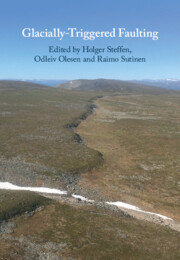Book contents
- Glacially-Triggered Faulting
- Glacially-Triggered Faulting
- Copyright page
- Contents
- Figures
- Tables
- Contributors
- Preface
- Part I Introduction
- Part II Methods and Techniques for Fault Identification and Dating
- 3 Earthquake-Induced Landforms in the Context of Ice-Sheet Loading and Unloading
- 4 The Challenge to Distinguish Soft-Sediment Deformation Structures (SSDS) Formed by Glaciotectonic, Periglacial and Seismic Processes in a Formerly Glaciated Area
- 5 Glacially Induced Fault Identification with LiDAR, Based on Examples from Finland
- 6 Fault Identification from Seismology
- 7 Imaging and Characterization of Glacially Induced Faults Using Applied Geophysics
- 8 Dating of Postglacial Faults in Fennoscandia
- 9 Proposed Drilling into Postglacial Faults
- Part III Glacially Triggered Faulting in the Fennoscandian Shield
- Part IV Glacially Triggered Faulting at the Edge and in the Periphery of the Fennoscandian Shield
- Part V Glacially Triggered Faulting Outside Europe
- Part VI Modelling of Glacially Induced Faults and Stress
- Part VII Outlook
- Index
- References
4 - The Challenge to Distinguish Soft-Sediment Deformation Structures (SSDS) Formed by Glaciotectonic, Periglacial and Seismic Processes in a Formerly Glaciated Area
A Review and Synthesis
from Part II - Methods and Techniques for Fault Identification and Dating
Published online by Cambridge University Press: 02 December 2021
- Glacially-Triggered Faulting
- Glacially-Triggered Faulting
- Copyright page
- Contents
- Figures
- Tables
- Contributors
- Preface
- Part I Introduction
- Part II Methods and Techniques for Fault Identification and Dating
- 3 Earthquake-Induced Landforms in the Context of Ice-Sheet Loading and Unloading
- 4 The Challenge to Distinguish Soft-Sediment Deformation Structures (SSDS) Formed by Glaciotectonic, Periglacial and Seismic Processes in a Formerly Glaciated Area
- 5 Glacially Induced Fault Identification with LiDAR, Based on Examples from Finland
- 6 Fault Identification from Seismology
- 7 Imaging and Characterization of Glacially Induced Faults Using Applied Geophysics
- 8 Dating of Postglacial Faults in Fennoscandia
- 9 Proposed Drilling into Postglacial Faults
- Part III Glacially Triggered Faulting in the Fennoscandian Shield
- Part IV Glacially Triggered Faulting at the Edge and in the Periphery of the Fennoscandian Shield
- Part V Glacially Triggered Faulting Outside Europe
- Part VI Modelling of Glacially Induced Faults and Stress
- Part VII Outlook
- Index
- References
Summary
This chapter gives an overview of the use of soft-sediment deformation structures (SSDS) as palaeoearthquake indicators in formerly glaciated and periglacial areas. We review the most important processes of soft-sediment deformation and the different nomenclature used in the scientific communities.
So-called seismites are beds with SSDS that formed because of seismic shaking. However, in regions that were affected by glacial and periglacial processes, the use of SSDS as palaeoearthquake indicator is challenging and interpretation must be done with care. Earthquakes are only one trigger process of many that can cause liquefaction and/or fluidization of sediments, leading to the formation of SSDS. Ice-sheet loading, glaciotectonism and freeze and thaw processes in glacial and periglacial environments are also potential trigger processes that can cause the formation of similar types of SSDS, which can be easily mistaken for seismites. Therefore, we provide clear criteria to recognize seismites in the field. The combination of deformation bands that occur in the vicinity of basement faults with carefully evaluated SSDS is a robust indicator for palaeoearthquakes.
Keywords
- Type
- Chapter
- Information
- Glacially-Triggered Faulting , pp. 67 - 88Publisher: Cambridge University PressPrint publication year: 2021
References
- 3
- Cited by



